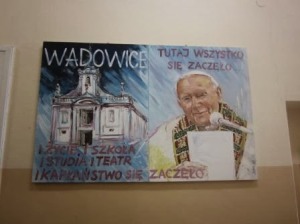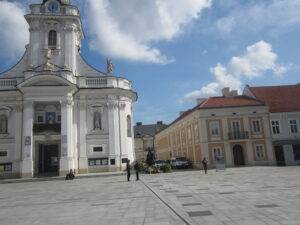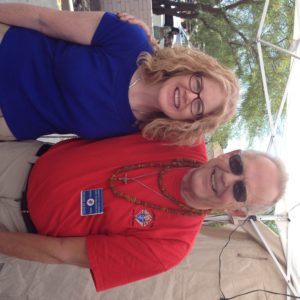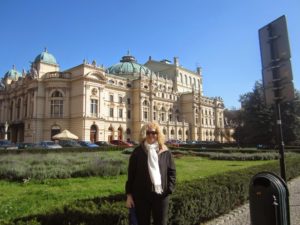 April 2014 is a big month for Catholics, Poles and fans of Pope John Paul II, nee Karol Wotyla. Besides the fact this is Holy week and Easter is in four days, on April 27, 2014 (the current) Pope Francis will declare Pope John Paul II and Pope John XXIII saints during a canonization ceremony in Rome.
April 2014 is a big month for Catholics, Poles and fans of Pope John Paul II, nee Karol Wotyla. Besides the fact this is Holy week and Easter is in four days, on April 27, 2014 (the current) Pope Francis will declare Pope John Paul II and Pope John XXIII saints during a canonization ceremony in Rome.
Pope John Paul II is like a ‘rock star’ in Poland

I truly don’t mean to be irreverent when I say Pope John Paul II is like a ‘rock star’ in Poland and for Catholics around the world. Statues of him fill every town, streets are named after him, even an airport bears his name. But now he really is a rock star – in the theatrical sense. The new Italian musical ‘Karol Wotyla: The Real Story‘ opened April 2 and 3 at Kraków’s beautiful Słowacki Theater. After a stop in Warsaw for a couple of performances the show will move on to Rome.
The timing is significant; Pope John Paul II passed away on April 2, 2005.

The National Bank of Poland has minted 1.7 million (500 zloty) in honor of the canonization; the bank is besieged with long lines for the relatively expensive souvenir (roughly $165.00).
April 9 the John Paul II Family Home Museum reopened in his hometown of Wadowice (about an hour’s drive west of Krakow.)
Pope John Paul II was born in Wadowice, ministered in Kraków

My good friend Mike Richard of livingkrakow.com is in Poland as I write this leading a group of pilgrims to celebrate Easter in Kraków, the home of PJP II in the month of his canonization.
Unless you’ve been under a rock, you know that Pope John Paul II is from Poland. In 1978, he became the first non-Italian to be named Pope since the Dutch Pope Adrian VI, who served from 1522 to 1523. I still remember news broadcasters struggling to pronounce his Polish last name. Born and raised in the small town of Wadowice, about an hour away from Kraków, he moved to Kraków after high school and enrolled in the Jagiellonian University. In 1949 he was ordained as an assistant pastor in Kraków parish. In 1958 he was named the auxiliary bishop of Kraków. His positive impact on the country of Poland is beyond measure. He is perhaps the most revered Pole of all time.
The Słowacki Theater in Kraków is Stunning

On a side note – I remember Henry pointing out a theater on a street map of Krakow. It’s directly across from the train station, so if exiting the train station it’s the first building you see. For some reason I had a movie theater in my mind. I was stunned when I saw this beautiful structure, especially lit up at night. The Słowacki Theater was closed when we were in Kraków; otherwise I’ve have bought tickets to almost any show just to see the inside.

2 Comments.
We 29 Pilgrims, mostly from Phoenix, traveled to Poland for Holy Week (leading up to Easter) and St. John Paul the Great’s Canonization a week later. Originally, we planned to travel to Rome for the Canonization, but by consensus we decided to remain in Krakow. The ceremonies were live-streamed to numerous locations in Krakow, including the new Sanctuary of St. John Paul the Great, the Divine Mercy Convent next door (where we were), the Blonie (meaning field) an immense grassy area where 3.5 million attended Mass in 1979 when the new Pope returned home for the first time, the historic City Center (Rynek). Also in nearby towns like Wadowice and Kalwaria Zebrzydowska. There was a huge crowd where we were. The ceremony began at 10:00am, but when I got up at 6:00 am, the crowds were already immense. The streets were blocked, so throngs arrived afoot. I used to do crowd estimates and we had an excellent vantage point near the crest of the hill, spreading about 1/2 mile in each direction in three directions. The basilica was in front of us with two huge screens. I’m sure the crowd was around 200,000. Even though we were high on the hill, I could not see the end of the crowd in any direction. Just next to us on another hill is the new Sanctuary of St. John Paul the Great. The crowd there was equally immense. Three university students noticed us and one, Agata, asked “Do you speak Polish?” I responded “Uchtyl Sie” (I am learning). She said she would translate for us, since the live stream was to be narrated in Polish. Not everyone was in Rome, even one group passed by speaking Italian.It is impossible to describe the moment, tens of thousands seemed connected by a common heartbeat.
After the Canonization and waiting several hours for the streets to reopen, we moved to the Krakow Center (Rynek) for a celebration dinner at the Wesele Restaurant. (Wesele can be translated as ‘wedding” or, for us, as “celebration”.) We then attended a concert at the Saint Mary’s Basilica historic church with magnificent altar that was stolen by the Nazis, but recovered and returned to Krakow after the war. The concert was by Benedictine Monks and male students from a monastery in a Polish neighborhood in London. They were wonderful. We still wanted to celebrate, so I asked Piotr to go around the corner and make reservations at Muniaki Jazz Club. This club is owned and operated by a Polish sax player named Muniak who was a “side man” for Louis “Satchmo” Armstrong for some of his European tours. He can still play. The club is literally “underground”. Krakow was destroyed by fire in the 10th Century or thereabouts and the present city built on top of the ruins. In recent decades, these underground rooms have been rediscovered and there about 300 clubs and restaurants operating under the “Old City”. They are constructed of big stones, placed without mortar and create a fun ambiance. There is even an underground mall being developed under the former site of the City Hall.